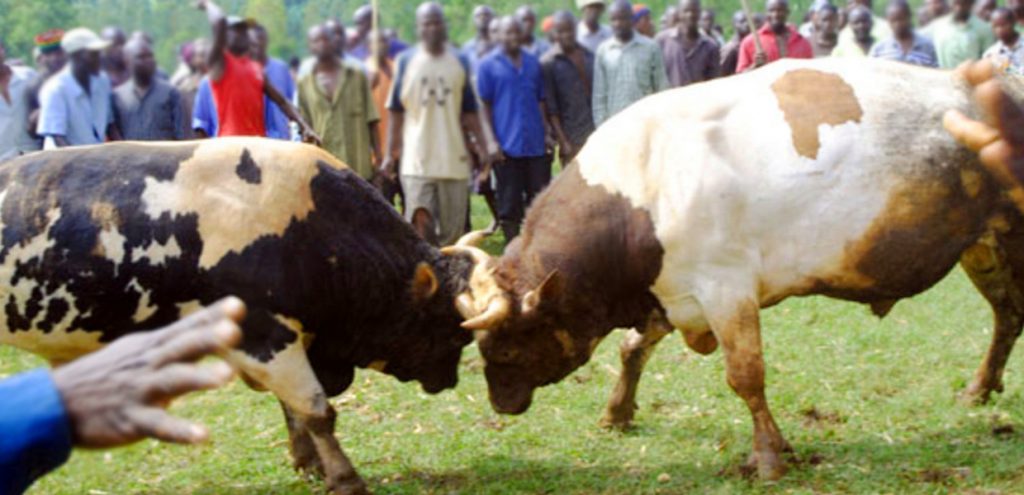The Mbale bull fighting tradition in Bududa began in 1956. Long before bull fights became a fascination, locals were engaging in infamous pastimes. It is said that locals used to gather and watch men wrestle and pierce each other with spears. The chiefs used to encourage men to fight out their differences and whilst no one was supposed to kill, there were many cases of terrible injuries. The infamous fights were however stopped after the intervention of colonial government officials.

Usually located near Bududa town on the hills of Mountain Elgon, the day designated for the bull fighting is usually a Saturday but fortnightly. Namasho playing field near Bulucheke secondary school is where the fights happen, though other places like Nabukasala in Bushika sub county have also recently instituted their own bull fights. Whereas some argue that bullfight is animal cruelty, others hope to see a modern tourist attraction centre set up for this event. Mbale bull fighting is one of the most unique tourist attractions in eastern Uganda. It is the only place in Uganda where bullfighting takes place.
The bulls involved in the fights are from 4-7 years and are brought in from different villages. They are trained and fed well before the fights. We feed them on kamasifwa (malwa residue) and banana stems. We also assign them names. This spawns the much needed dynamism in the rowdy bulls as they battle.
Once the spectacle began, everyone excitedly moved towards the focal point. The bull owners engaged in the fights are kept at a close distance.
There cannot be a cessation once the bulls lock horns. If one bull kills the other, there is no case the owner of the dead bull can bring up. It is only when a defeated bull runs off that the fight can be called off. This place is like a ring for people who had bones to pick with each other and which have become a custom in long way.
Origin of Mbale Bull Fighting
From the mid 1950’s to 1970’s, the fights were not taken serious. The practice was more of an occasional and casual pastime for local herdsmen especially in Namasho. In the course of grazing, they would let their bulls engage in fights for fun.
Fights often broke out between the male bulls when the females were brought for mating. The owners of the bulls reportedly gave them intoxicating local herb leaves to spark fights.
The bull fighting custom grew by leaps and bounds after Kundu’s exploits. In Namasho village, everyone talks of an infamous bull owned by Kundu. It reportedly bit off the ears of more than 25 other bulls after subduing them in fights. Namasho was eventually chosen by village committees as the place that would be hosting the fights.
Namasho already enjoyed a reputation for its stone shaped salty underground water wells, which the locals believed made their cows produce more milk.
In this place, bulls that were brought to drink the salty water could be instigated to fight over anything to show off their prowess, in the presence of females.
Few days before the bull fights start, the bulls are kept in kraals and are fed for 24 hours. Some bull owners keep their bulls in kraals for a year and only let them out, when they are going to be slaughtered, sold or when they are going to engage in fights.
At the time of fighting
Before the bulls engage in battle, they are bathed in the nearby Manafwa River. According to local folklore; the water is an antidote for stress.
More bulls are introduced to the game as their owners lead them across the big field to find an opponent. The younger and smaller bulls are paired with same-sized bulls while the bigger ones are paired with the more muscular bulls that can weigh between 500kg to 800kg. The battlefield is usually crowded with over 50 bulls. Owners beat their bulls to force them to go towards the direction they ought to be at. It is the owner’s mission to find the perfect fighting partner for his bull.
Most of the bulls are given interesting names, ranging from Nakhakambila (outlaw), Nabuminyi (rebel) and Namani (the powerful one).
The bulls are pitted in battles against each other for 5 to 15 minutes, depending on how aggressive, agile and tough they are.
Once the bull is led to its competitor, it slowly approaches him. They later provoke one another in a locking horns-dance while pushing each other around. After a few minutes of obstinate locked horns, the bulls try to attack with even more strength, fighting more vigorously, pushing each other away. It is easy to see who will lose as he tries to withdraw from the battle. Running backwards the bull is stopped by its owner who, with beats forces it back to the fight despite that his opponent is stronger and most likely will win. The fight ends when the defeated bull finally runs backwards away from the arena, for good.
In the course of the grueling fights, the bulls are not given leeway to rest or catch a breather.
To make the bulls summon the courage and strength to fight even harder it is constantly lashed by the owner or the judge to taunt them to fight harder and once the bulls get lashed they get exasperated and that is when the fights intensify.
The victorious bulls are pampered after the fights. Their triumph spells prestige for the bull owners and the villages participating.
The owners of the losing bulls have to part with either malwa or money as agreed upon prior to the fight, while the owner of the victorious bull takes home a bigger prize of money or malwa.
Communities and Mbale Bull Fighting
Revelers state that these bulls get stronger and stronger, which brings fun, while helping bringing people together, so it’s a major social event.
Though often associated with foreign countries, the bull fighting sport is slowly gaining tourism importance in Uganda,
Participants and viewers come from as far as Bubita, Bukalasi, Buwali, Bukikayi, Bushiki, Bumayoka, Mabono, Bushiyi sub-counties with bulls trained to fight.
It also argues that the fights improve their appetite, build their necks and chests, and help them work off excess energy, thus stopping them from being destructive and hostile.
The fights improve their appetite, build their necks and chests, and help them work off excess energy, thus stopping them from being destructive and hostile. The farmers believe that bullfight is a healthy practice as it supposedly keeps the bulls fit. This way the farmers can sell the bull at a higher price since its strength has been validated. Farmers with a winning bull also enjoy more respect in the community. For many, bullfight has always been there.
Bullfighting is a part of the Bududa peoples’ cultural heritage. It has been in practice since the 1950s, though some sources indicate from the late 60s. Elders pray to their gods before the fight as a symbol of respect to ancestors, who they believe initiated the sport even earlier. However, the practice regained popularity ten years ago with the opening of the main fighting center in Bulucheke, where hundreds of bulls are brought in from neighboring villages and districts like Manafwa
Besides Mbale bull fighting, Uganda is a rich multi-cultural country, so don’t miss out on experiences with the nearby Bagisu or Bamasaba people, Iteso people, Sebei people, and further northeast, the famous Karamojong group or Ike community. Get mesmerized by the Batwa trail in both Bwindi Impenetrable National Park and Mgahinga Gorilla National Park. While in Bwindi, you can also also opt for the breathtaking gorilla trekking experience.
